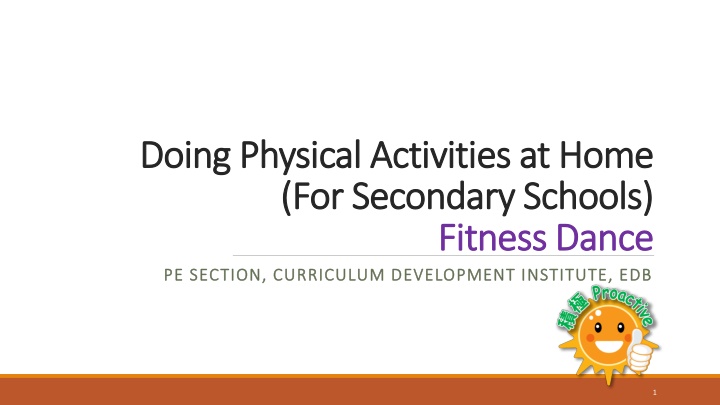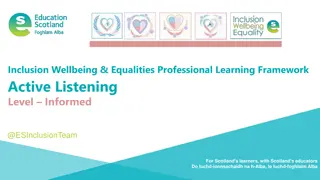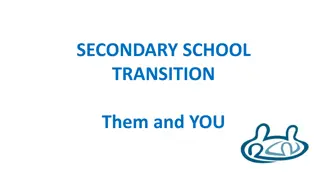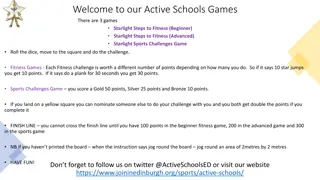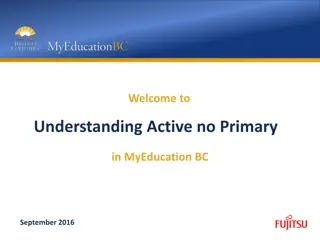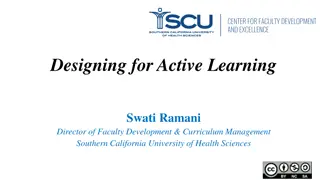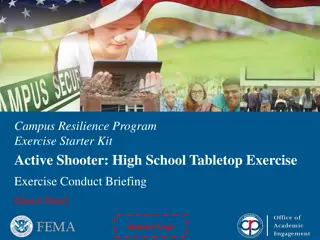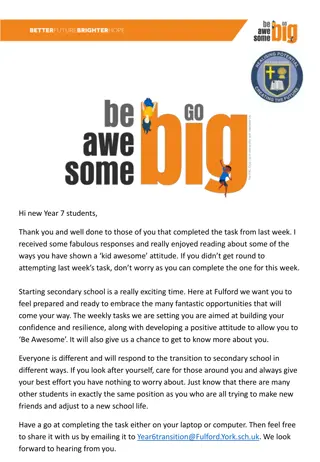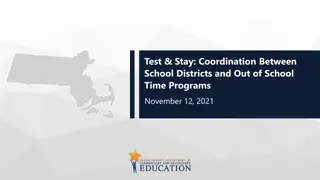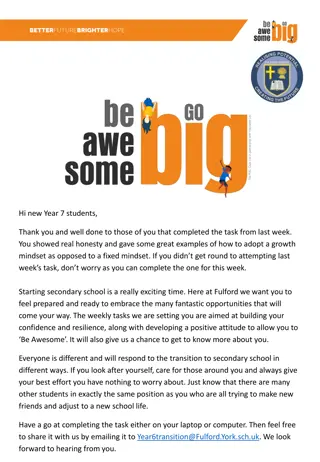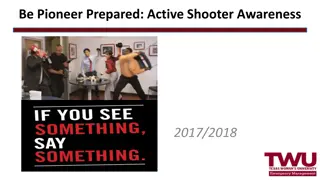Encouraging Secondary School Students to Stay Active at Home
Department of Health emphasizes the importance of regular physical activity from childhood to adulthood for overall health benefits. The Curriculum Development Institute provides resources for teachers and parents to promote individual physical fitness activities at home, aiming to improve fitness levels, reduce health risks, and strengthen parent-child relationships. Safety measures and guidelines for effective physical activity are outlined, emphasizing the gradual progression of intensity, proper warm-up, hydration, and personal hygiene. Resources for fitness dance activities are also available to support students in maintaining a healthy lifestyle.
Download Presentation

Please find below an Image/Link to download the presentation.
The content on the website is provided AS IS for your information and personal use only. It may not be sold, licensed, or shared on other websites without obtaining consent from the author.If you encounter any issues during the download, it is possible that the publisher has removed the file from their server.
You are allowed to download the files provided on this website for personal or commercial use, subject to the condition that they are used lawfully. All files are the property of their respective owners.
The content on the website is provided AS IS for your information and personal use only. It may not be sold, licensed, or shared on other websites without obtaining consent from the author.
E N D
Presentation Transcript
Doing Physical Activities at Home Doing Physical Activities at Home (For Secondary Schools) (For Secondary Schools) Fitness Dance Fitness Dance PE SECTION, CURRICULUM DEVELOPMENT INSTITUTE, EDB PE SECTION, CURRICULUM DEVELOPMENT INSTITUTE, EDB 1
Preface Preface Department of Health indicated that maintaining regular physical activity starting from childhood to adult stage will bring about tremendous health benefits and enhance physical fitness, such as increased cardiorespiratory fitness and muscular strength; reduced body fatness; lower risks of developing cancer, cardiovascular diseases and diabetes; enhanced bone health; and building resilience and reducing symptoms of depression. Besides, to maintain a healthy lifestyle could build up good body resistance. The Curriculum Development Institute of Education Bureau developed a series of learning and teaching materials for teachers reference in encouraging students to do individual physical fitness activities at home. Also, parents should provide necessary support to or take part in the activities with their children. It could foster parent-child relationship and help them maintain a good health condition which leads to a healthy lifestyle.
Safety Measures Safety Measures To wear proper clothing and footwear during activities. Exercises should be carried out individually or on a rotation basis. Adequate distance should be maintained with other people. Before activities, the floor should be ensured smooth and dry; indoor area should be kept well ventilated; adequate space and safe environment should be arranged; any glass windows, doors, table, chairs, lights, fans and sharp edges, etc. which are in close vicinity to the activity area should be installed with protective devices or be temporarily removed; all equipment must be checked for safety before use. Students should do adequate warm-up exercises at the beginning of the activity. The intensity1, duration and frequency of exercises should be arranged according to the personal health and fitness conditions. It should be started from the lowest level of difficulty. The intensity, duration and number of repetitions should be increased gradually. Natural breathing instead of holdingbreath should also be reminded. Pay attention to the voice volume when engaging in activities to avoid disturbing others. To drink water after the activity for replenishment. Personal hygiene should be observed. If feeling unwell during or after the activity, students should stop immediately and seek medical or professional assistance. Note1:The intensity of physical activities can be classified into low, moderate and vigorous levels: Low-intensity physical activities are simple, light and easy to do. Moderate-intensity physical activities will slightly speed up breathing and heart rate and cause mild sweating without exertion (e.g. one can still talk with ease while exercising). Vigorous-intensity physical activities will greatly speed up breathing and heart rate and cause profuse sweating and exertion (e.g. one cannot or finds it difficult to talk with ease while exercising).
Learning and Teaching Learning and Teaching Resources Resources Fitness Dance Fitness Dance 4
Warm Warm- -up up https://apps.hkedcity.net/media/play/playVideo_responsive.php?vFileID=78521&vLang=chi&videoUrl= cb7e2db2e5e7489f0e79165df0e5949cbe16b8c4e354ef1d1f5feb0868512c55e6a0ee9d7310c1726b542 48b5f597c5c3188cbc2f136bbc4d1856ab209f0ce77 Instructions: 1. To cater for learner diversity, the movement of each dancers were differently designed. Students could watch the video first and choose the dancing steps that suits your their ability for warm-up. 2. Students can challenge themselves one by one according to their ability, and they can also create their own dancing movements. 5
Single movements of Fitness Dance Single movements of Fitness Dance http://www.hkpfa.org.hk/CustomPage/paragraphGroup.aspx?ct=customPage&webPageId=106 &pageId=144&nnnid=111 Click on the link above to select different steps to practice. (If you wish to practice from elementary level, please refer to Doing Physical Activity at Home (For Primary Schools) - Fitness Dance) 6
Creation of Fitness Dance Routine Creation of Fitness Dance Routine 1. Practice single movements of the upper and lower limbs, then try to combine upper and lower limbs movement and practice. Example Combinations Upper Limbs Lower Limbs 1 Arm Curl Leg Curl 2 Arm Row Step Touch 3 Arm Push Grapevine 4 Arm Row Leg Curl 2. Compose a new dance routine by joining various combinations of movement of different body parts according to the rhythm of the music. 3. Please refer to the Fitness Dance Routine of the webpage. Individual III Individual I Individual II - https://youtu.be/fMPfIYEb_0Y - https://youtu.be/wp9Wc-YsqDQ - https://youtu.be/QixwmnQ-Je8 7
The World Health Organisation recommends that children and youth aged 5-17 should accumulate at least 60 minutes of moderate- to vigorous-intensity physical activities daily. Set clear goals for yourself. You can! 8
